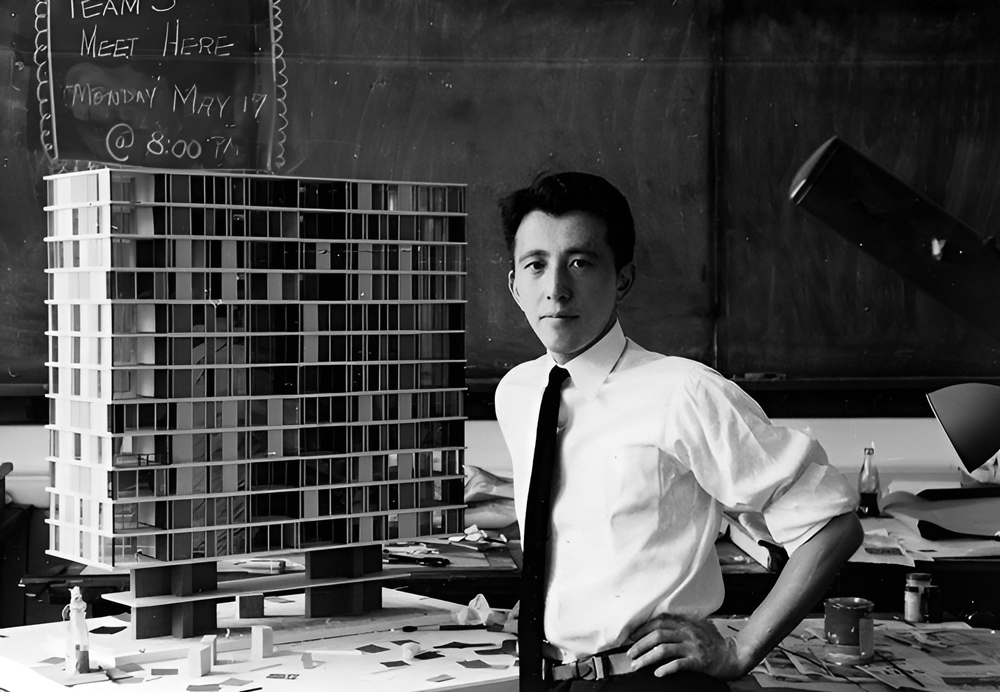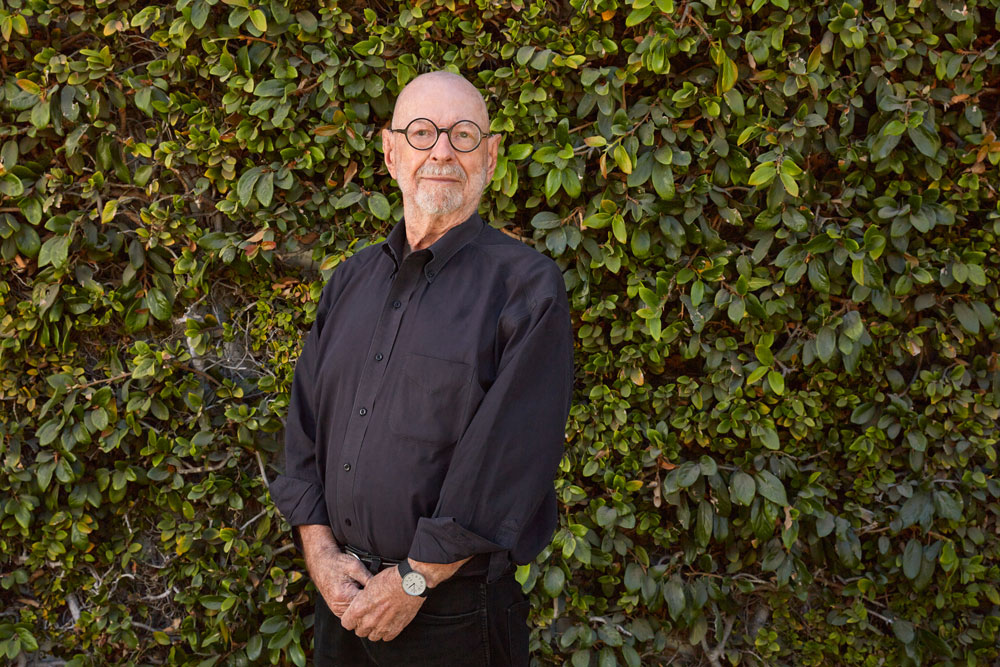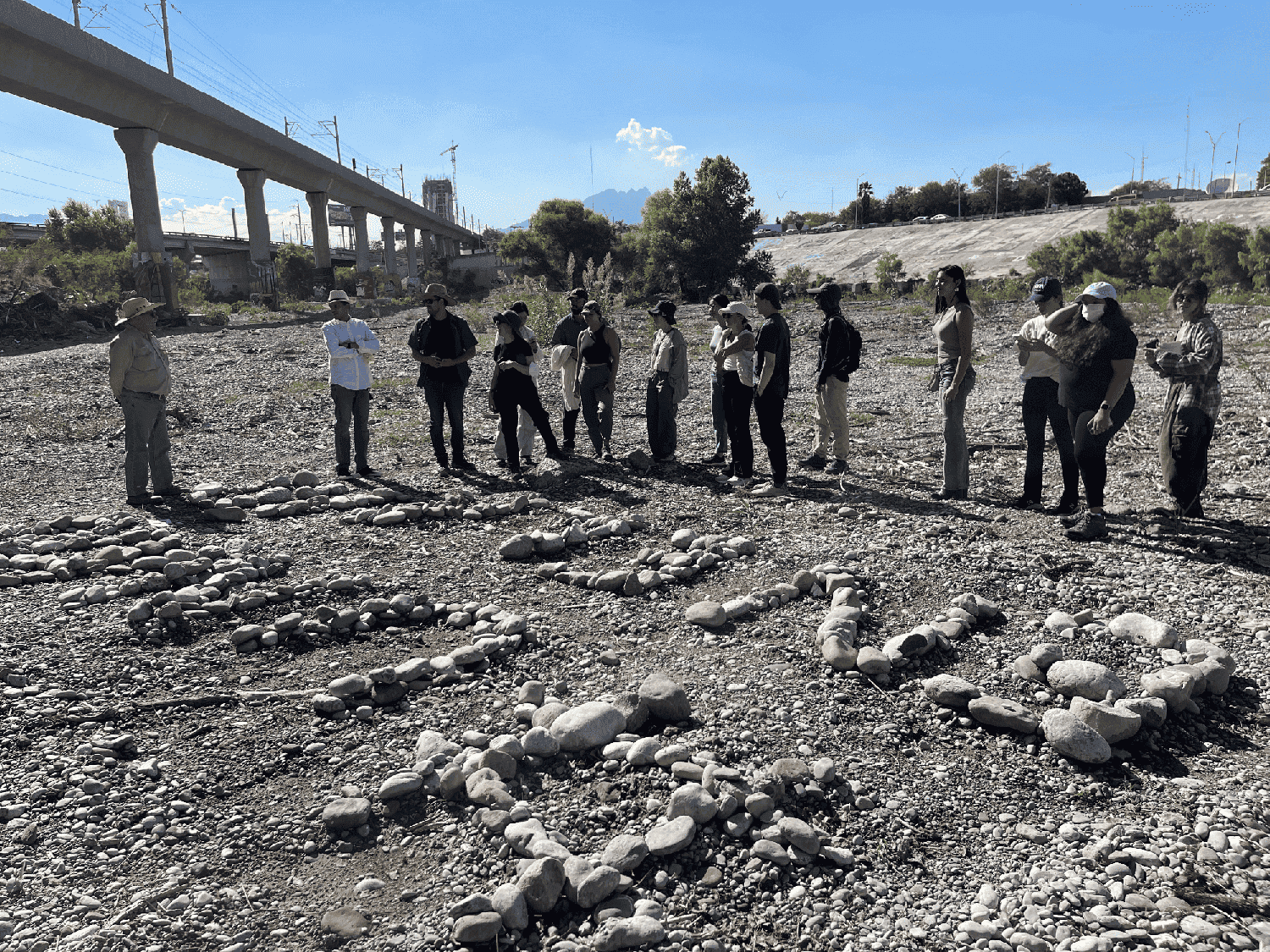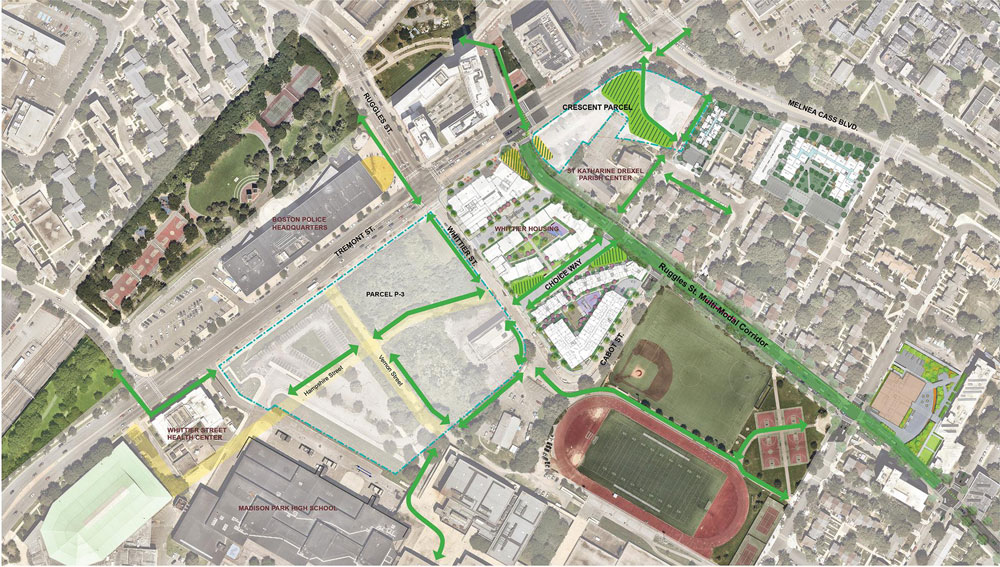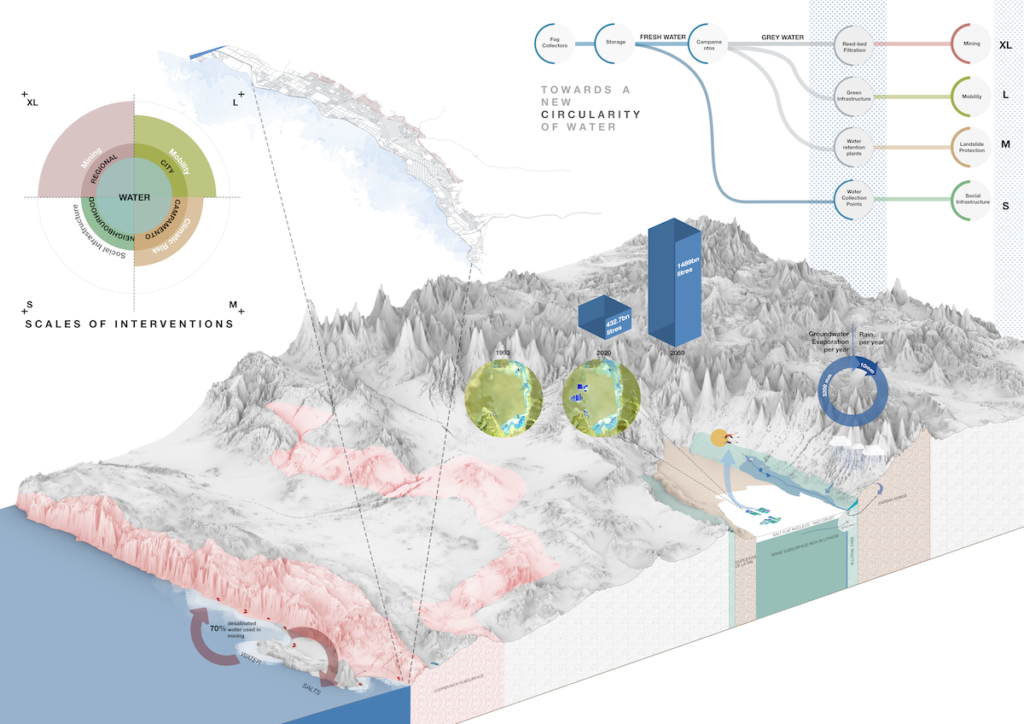Remembering Fumihiko Maki (1928–2024)
A graduate of the University of Tokyo and Harvard Graduate School Design (GSD; MArch ’54), Fumihiko Maki was among the most distinguished Japanese architects of the past century. Yet, despite all his laurels and awards—the second Japanese recipient of the Pritzker Prize, after Kenzō Tange; the Praemium Imperiale; and the GSD’s own Veronica Rudge Green Prize in Urban Design—Maki-san was uniquely approachable, eager to listen and generous in sharing. Studying under Tange in Tokyo and then Josep Lluís Sert at the GSD, Maki’s intellectual formation coincided with the halcyon days of postwar reconstruction. While indebted to his teachers, both giants of this particular epoch of CIAM modernism, Maki came of age as part of the postwar cohort that strove for a more nuanced, sensitive view of the relationship between architecture and the urban environment, bringing him into the fold of the Team 10 group together with the likes of Jaap Bakema and Aldo van Eyck.1
Maki’s legacy to the world of architecture and urban design is undoubtedly his theorization of Group Form as a spatial idea, bringing together the scale of the room with that of the city while anticipating movement, even growth and change. A project that first began in 1967, not long after Maki’s return to Japan from the US, Hillside Terrace in Tokyo’s Daikanyama Neighborhood exemplifies Maki’s idea of Group Form. Evolving over a period of three decades, the project saw a series of internally coherent parcels that gradually extended along Tokyo’s Old Yamate Avenue, each articulated with a gentle, nuanced transition from the busy thoroughfare to quiet, intimate mixed-use spaces toward the back. Now more than a half century later, Hillside Terrace still exudes a remarkable sense of vitality and contemporaneity—celebrating the atmosphere and spatial qualities of a traditional residential neighborhood in a language that is unmistakably modern.
I first met Maki-san not long after arriving in Japan, in 2005, to begin my research on Tange. In those first months I talked to as many people as I could about Tange, Metabolism, and modern architecture in Japan in general. The vast majority of those I met simply repeated well-trodden, seemingly perfunctory tropes. That was not the case with Maki-san, who was easily the most distinguished figure I encountered. He showed genuine interest in first hearing why I was interested in Tange, and he went on to share stories of his time together with Tange, matter-of-factly. Maki spoke of his experiences as an undergraduate in Tange’s studio and subsequent interactions through the Metabolist Group and other occasions, such as at a dinner related to the Kennedy Presidential Library project, when he was seated between Tange and Paul Rudolph as something of a translator for his former mentor. More than any of the others I met, Maki had a profound appreciation for the global dimension of Tange’s work and understood the importance of making an architecture that is for the world.

Some years later, when I took up a teaching position at Washington University (WashU) in St. Louis, this connection with Maki-san was renewed. My favorite perk was my office on the second floor of Steinberg Hall, built in 1960 by the then 32-year-old Maki for the university art gallery and art and architecture library. Maki joined the faculty at WashU in 1956, staying until 1962 when he was called by his other mentor, Sert, to rejoin the GSD as a faculty member.
Maki’s urban formulation had its origins in the round-the-world travels he undertook in 1959–60, courtesy of a fellowship from the Graham Foundation. Rejecting earlier, modernist conceptions of urban assemblages as either Compositional Form or Mega Form, Group Form entailed a freer, more open, dynamic—even a democratic relationship—in the spatial arrangement of urban elements. He found inspiration in the Panathenaic Stadium in Athens, hill towns of Greece and Italy, and charbaghs of Isfahan and Damascus.
The travel bug stayed with Maki his whole life, and he indulged in the anonymity and freedom of the solitary traveler. Unlike many other Japanese architects of his stature, Maki-san seldom traveled with an entourage, not even a kabanmochi, or briefcase carrier. The Graham travels had a profound impact on him, and he retained an almost childlike pleasure in planning his own business trips. This was mirrored in the daily routine that he continued well into his late eighties: walking from his home just south of Tokyo’s center to the local train station, taking the Yamanote Line to Shibuya, and then transferring to the neighborhood shuttle bus to his office in Daikanyama. The silhouette of Maki-san, wearing his dark navy blazer and walking in a light but determined gait, will forever be part of the mental scenery of Hillside Terrace, which he helped create.
- For more on Maki and Metabolism, see Fumihiko Maki, Investigations in Collective Form (St. Louis: School of Architecture, Washington University, 1964); and Eric Paul Mumford, Defining Urban Design: CIAM Architects and the Formation of a Discipline, 1937–69 (New Haven: Yale University Press, 2009). ↩︎
Summer Reading 2024: Design Books by GSD Faculty and Alumni
Building your summer reading list? This selection of recent publications by Harvard Graduate School of Design faculty and alumni—organized alphabetically by title—includes design-related topics from wildfires to the Tower of Babel.
In Absolute Beginners (Park Books, 2022) Iñaki Ábalos, design critic in architecture, addresses innovation in architecture, examining the ways in which architectural creation, like philosophical thought, intertwines with reflections on the past and appropriations of recurring challenges.
Approaching Architecture: Three Fields, One Discipline (Routledge/Taylor & Francis, 2023) interrogates the relationship of research, pedagogy, and professional practice. Edited by Miguel Guitart (MArch ’03), the book collects 18 contributions from around the globe that challenge the discipline’s compartmentalization. One reviewer characterizes the compilation as “a thoughtful and engaging set of arguments, provocations, and reflections that work collaboratively, curiously, and critically to help reconsider the necessary entanglements of architecture’s ‘three fields.’”

In Architecture After God: Babel Resurgent (Birkhäuser, 2023), Kyle Dugdale (MArch ’02) explores the Tower of Babel as a concept aligning architecture and morality from ancient Babylon to twentieth century Europe, where early modernism’s idealism collided with the rising nationalism that prefigured World War II. “Dealing in structural metaphor, utopian aspiration, and geopolitical ambition, the book’s narrative”—in the words of the publisher—”exposes the inexorable architectural implications of the event described by Nietzsche as the death of God.”
Architecture and Micropolitics: Four Buildings 2011-2022 (Park Books, 2022), by professor in practice of architecture Farshid Moussavi (MArch ’91), investigates the relationship between architecture and society, using Moussavi’s work to highlight the architect’s enduring relevance and demonstrate how buildings can be grounded in the micropolitics of everyday life. The book includes essays by GSD design critic in architecture Iñaki Ábalos and others.
Architectures of Transition: Emergent Practices in South Asia (Edicions Altrim S.L., 2023), written by John T. Dunlop Professor in Housing and Urbanization Rahul Mehrotra, Devashree Shah (MArch II ’23), and Pranav Thole (MArch ’23), draws on a conferences series that took place from March 2022 to March 2023. The publication foregrounds conversations around architecture and evolving models of practice in India, Pakistan, Bangladesh, Afghanistan, Sri Lanka, Nepal, Bhutan, and the Maldives.
Armadillo House: A Conversation between Marc Camille Chaimowicz and Roger Diener (Walther König, 2023), edited by Fredi Fischli and Niels Olsen—John Portman Design Critics in Architecture—with Cristina Bechtler, presents a discussion between artist Chaimowicz and architect Diener covering their collaboration on The Armadillo House in Basel, Switzerland. The book details their respective artistic visions and differing approaches to spatial arrangements.

The established horticultural practice of grafting connects two living plants, one old and one new, to grow and thrive as one. In The Art of Architectural Grafting (Park Books, 2024), professor in practice of architecture Jeanne Gang (MArch ’93) applies the notion of grafting to existing buildings and urban lands as a paradigm for rethinking adaptive reuse and addressing climate change. Through theoretical essays and architectural examples, Gang explicates the concept of architectural grafting, urging her peers to “renew our role as cultural leaders who envision and create a different future” by “add[ing] capacity to what already exists, caring for the old and simultaneously making original contributions to it.”
In Atlas of the Senseable City (Yale University Press, 2023), Antoine Picon, G. Ware Travelstead Professor of the History of Architecture and Technology, and Carlo Ratti explore how sensing technologies associated with digital mapping impact everyday life. Ubiquitous sensors offer new ways to visualize cities with implications that touch on many areas, from making municipalities more efficient to assisting in the support of vulnerable urban populations.
Edited by Michael Van Valkenburgh—Charles Eliot Professor in Practice of Landscape Architecture, Emeritus—and Elijah Chilton, Brooklyn Bridge Park: Michael Van Valkenburgh Associates (Monacelli, 2024) chronicles the transformation of 85 acres of Brooklyn’s post-industrial landscape into a waterfront park that stretches 1.3 miles along the East River. This book explores the firm’s efforts, over 23 years, to convert parking lots and derelict piers into a public recreational space and living ecosystem.
For a century, Zurich—a center of global finance and Switzerland’s largest city—has embraced, within its for-profit real estate market, a cooperative model that supports nonprofit housing. Cooperative Conditions: A Primer of Architecture, Finance, and Regulation in Zurich (gta Verlag, 2024), edited by design critic in urban planning and design Susanne Schindler with Anne Kockelkorn and Rebekka Hirschberg, examines the interplay between housing’s architectural, regulatory, and fiscal instruments, rendering aspects of Zurich’s cooperative model applicable for other locations.

Design by Fire: Resistance, Co-Creation, and Retreat in the Pyrocene (Routledge, 2023) by Emily Schlickman (MLA ’12) and Brett Milligan addresses our relationship with, and vulnerability to, wildfires. Nearly thirty case studies categorized into three approaches—resisting, embracing, and retreating—offer possible design strategies for building in fire-prone landscapes. One reviewer described Design by Fire as “the essential guidebook and atlas for the pyro-future that is already here,” offering “a foundation for understanding—and living in—the world to come.”
With Design Thinking and Storytelling in Architecture (Birkhäuser, 2024) Peter Rowe—Raymond Garbe Professor of Architecture and Urban Design and Harvard University Distinguished Service Professor—and Yoeun Chung (MAUD ’19, DDes ’22) explore design thinking, posited as “a fundamentally different way of knowing the world and a particular form of addressing creative problems.” The authors assert that designing rests on underlying principles of inquiry, and storytelling is preceded by a process involving empathy or careful listening. The book illustrates examples of testing and prototyping that generate a deeper understanding of architecture.
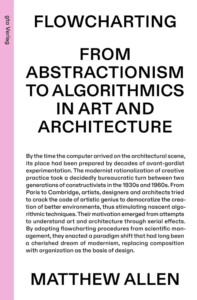
Flowcharting: From Abstractionism to Algorithmics in Art and Architecture (gta Verlag, 2023) by Matthew Allen (MArch ’10) investigates mid-twentieth-century experimentation that harnessed serial effects to create art and architecture. As Allen writes, “by adopting flowcharting procedures from scientific management, [the avant-garde] enacted a paradigm shift that had long been a cherished dream of modernism, replacing composition with organization as the basis of design.”
Design critic in architecture Andrew Heid penned the introduction to Glass Houses (Phaidon Press, 2023), a lavishly illustrated publication presenting 50 homes, dating from the early modern era through today, built almost entirely from glass. Featured architects include Tatiana Bilbao, Lina Bo Bardi, Ofis Architekti, Herzog & de Meuron, Hiroshi Nakamura, Kazuyo Sejima, Philip Johnson, Mecanoo, John Lautner, Richard Rogers, and Mies van der Rohe.
Lina Ghotmeh, Kenzo Tange Design Critic in Architecture, worked closely with editors Alexa Chow and Natalia Grabowska to document her firm’s pavilion at the Serpentine Galleries in Kensington Gardens, London. Titled Lina Ghotmeh – Architecture – À Table!: Serpentine Pavilion 2023 (Walther König, 2023), the catalog contains illustrations and contributed essays, as well as a lengthy interview with Ghotmeh conducted by renowned critic and curator Hans Ulrich Obrist.
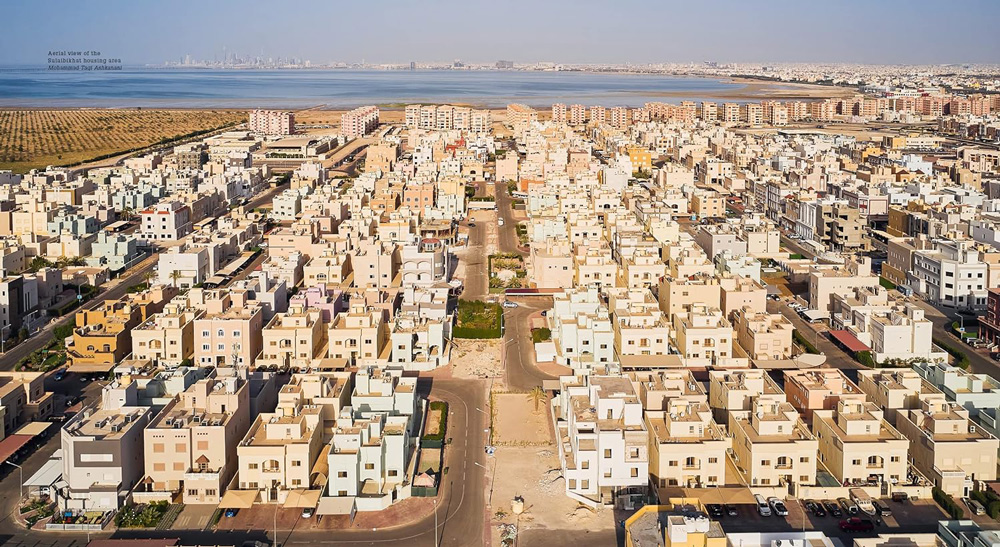
In The Multiplex Typology: Living in Kuwait’s Hybrid Houses (DOM Publishers, 2022) authors Joaquín Pérez-Goicoechea (MArch ’02), Sharifa Alshalfan, and Sarah Alfraih issue a call for alternative approaches to housing that are rooted in cultural specificity and adaptability. They focus on the multiplex—a ubiquitous yet officially unacknowledged form of multi-family housing that hides behind the facades of the single-family villa—arguing that this unique type offers a viable option for contemporary housing development in Kuwait.
Sarah Oppenheimer: Sensitive Machine (DelMonico Books/Wellin Museum of Art, 2023), edited by Tracy L. Adler, details four interactive artworks created by Sarah Oppenheimer, design critic in architecture, for the Wellin Museum of Art at Hamilton College. As Adler notes, “Oppenheimer’s work challenges us to consider how interactions with the built environment shape not just those who occupy a particular space, but how their presence impacts the space itself: how we fill and move through a space, how we adapt a space to our needs even when we are subject to its limitations.”

In Silt Sand Slurry: Dredging, Sediment, and the Worlds We are Making (AR+D, 2023), Gena Wirth (MLA ’09, MUP ’09), Rob Holmes, and Brett Milligan explore sediment’s role in shaping and facilitating modern life. As the book’s description notes, “Anthropogenic action now moves more sediment annually than ‘natural’ geological processes—yet this global reshaping of the earth’s surface is rarely discussed and poorly understood.” The authors outline an adaptive approach to designing with sediment as opposed to continuing current management practices, which often negatively impact larger ecological and human systems.
John Portman Design Critics in Architecture Fredi Fischli and Niels Olsen edited Sylvie Fleury: Double Positive (Jrp Ringier Kunstverlag Ag, 2022) to accompany an exhibition on the artist’s work that ran from October 2022 through March 2023 at the Bechtler Stiftung in Zurich. The book offers new insight into Fleury’s 1990s fashion collection, which the artist arranged as intentional mises-en-scène concerning consumerism and fetishization.
Segregation and Resistance in the Landscapes of the Americas (Dumbarton Oaks Research Library and Collection, 2023) draws on a 2020 Dumbarton Oaks symposium, assembling essays on the histories of segregation and resistance. Edited by Eric Avila and Thaïsa Way, lecturer in landscape architecture and director of Garden and Landscape Studies at Dumbarton Oaks, this collection considers how cultural and spatial practices of separation, identity, response, and revolt are shaped by place and inform practices of place-making.
Sharing Tokyo: Artifice and the Social World (Actar, 2023) collects essays and drawings focused on the theme of sharing Toyko’s urban space. Co-edited by Alexander and Victoria Wiley Professor of Design and Harvard University Distinguished Service Professor Mohsen Mostafavi and Kayoko Ota, the book offers insights, new perspectives, and speculative experiments in Tokyo’s urbanism and architecture that can be transferred to other contexts.
Technical lands, spaces united by their “exceptional” status, range from demilitarized and disaster exclusion zones to prison yards, industrial extraction sites, and airports. Edited by Charles Waldheim, John E. Irving Professor of Landscape Architecture, and Jeffrey S. Nesbit (DDes ’20), Technical Lands: A Critical Primer (JOVIS, 2022) assembles writings representing diverse disciplines, geographies, and epistemologies to illuminate the meaning, political implications, and increasing significance of these spaces.
In Thinking and Building on Shaky Ground (Birkhäuser, 2023), Yun Fu (MArch I AP ’15, DDes ’20), design critic in urban planning and design, explores strategies for earthquake-resilient architecture. Marrying technical knowledge with social and cultural understanding, these approaches allow for the development of contextual solutions applicable to all scales, from furniture to urban plans.
Urban Natures: A Technical and Social History, 1600-2023 (Pavillon de l’Arsenal, 2024), by G. Ware Travelstead Professor of the History of Architecture and Technology Antoine Picon, examines the history of nature’s place in cities through the lenses of urban planning, public health, food systems, and aesthetics. The publication accompanies an exhibition at Paris’s Pavillon de l’Arsenal mounted from April through September 2024.

Vincent Scully: Architecture, Urbanism, and a Life in Search of Community (Bloomsbury, 2023) by A. Krista Sykes (PhD ’04) details the life, career, and legacy of the architectural historian and critic Vincent Scully (1920–2017). Emerging in the 1950s as a guiding voice in American architecture, Scully investigated topics ranging from ancient Greek temples and Pueblos of the American Southwest to the work of Robert Venturi, Aldo Rossi, and New Urbanism. Scully believed that architecture shapes and is shaped by society, and that the best architecture responds to the human need for community and connection.
Resourceful Urbanism: Dan Stubbergaard’s Adaptive Reuse of Cities
Even before the last flight had taken off from Berlin’s Tempelhof Airport, in 2008, the future of the historic airport’s 355-hectare site was the subject of intense dispute. Competing plans to transform the area into new residential neighborhoods and commercial areas, integrating the vast airfield into the surrounding urban fabric, stalled amid protests against development. Instead, the airport reopened as Tempelhofer Feld, the city’s largest public park. The proximity to the city center that had made the airport a commuter hub also contributed to the park’s popularity, even with intact runways crossing the open greenspace. Yet amid demands for more affordable housing and increasing concerns about sustainable growth amid the climate crisis, the future of the vast Tempelhof site and its surroundings remains unclear.

In the Spring 2024 option studio City as Resource, GSD Professor in Practice of Urban Design Dan Stubbergaard challenged students to develop plans for new housing in an area surrounding the Teltow Canal, which runs just south of Tempelhofer Feld. The concept of adaptive reuse is at the core of Stubbergaard’s studio, as well as his own practice. Rather than seeking proposals to tear down existing structures or build new ones, Stubbergaard asked students to explore how “retrofitting existing situations can contribute to the creation of neighborhoods with improved living conditions, sense of community, and social balance.” Beyond conserving resources, wise applications of adaptive reuse can support growth that reflects established communities, especially in a city like Berlin that has an existing tradition of repurposing buildings.
In an April 9 talk at the Graduate School of Design , also titled “City as Resource,” Stubbergaard described himself as “a very strong believer in the city and also the city as a design phenomenon, which can solve and deal with many of these challenges we have faced, but also are facing in the future.” He pointed to targets set by the European Union to eliminate net carbon emissions by 2050 while also restricting the use of new land for development. These parameters make adaptive reuse a necessity since existing structures constitute embodied carbon—an investment in emissions made by previous generations. Adaptive reuse is especially effective when combined with planning approaches geared toward density, which allows for more efficient transportation and energy use. Stubbergaard described his mission to define “how we live closer, live smarter, and also create better social solutions in a much more dense environment than we have used to before.”

Stubbergaard presented an overview of work being done by Cobe, his Copenhagen-based firm. Since its founding in 2006, Cobe has built more than 36 projects in its home city alone. Some of the firm’s most iconic projects are in Nordhavn, a former industrial waterfront that Cobe won the competition to masterplan in 2008. This multi-decade project is adaptive reuse at an urban scale, with a network of docks to create a new neighborhood of dense housing connected by transit and bike lanes. The 160 architects, landscape architects, and urban designers who now make up Cobe live out the group’s principles by working together in an office in a repurposed warehouse in Nordhavn.
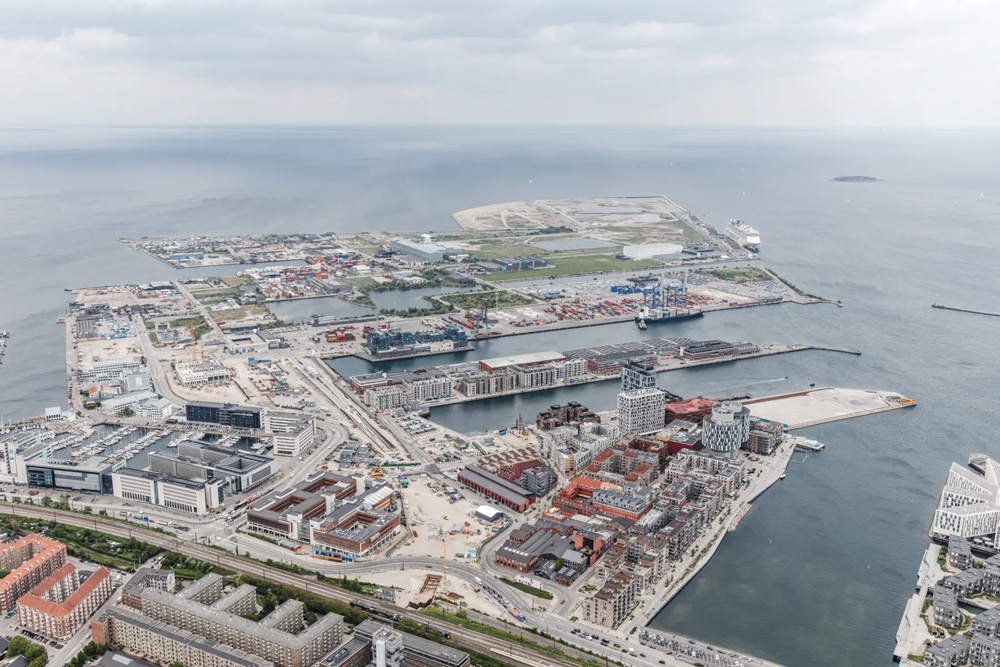
The firm’s work focuses on seven thematic areas: resilient urban development, infrastructure for a changing climate, adaptive reuse, longevity and adaptability, new ways of building, social capital, and urban nature. “I think we need to see our profession as creators of solutions for the future,” Stubbergaard said. Among the most stunning efforts at adaptive reuse is The Silo, a former grain silo that Cobe transformed into a residential complex with public facilities on the ground floor and roof. The project reused 2700 cubic meters of concrete. Cobe’s plan for the Frederiksberg School of Culture and Music repurposed parking space into a series of courtyards on the grounds of the Radio House, the former headquarters of the Danish Broadcasting Corporation. The Roskilde Folk High School, another arts-focused high school, sits on the site of a former concrete factory whose existing structures have been transformed into space for art workshops, dance halls, and music studios.
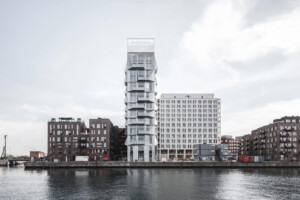
In Stubbergaard’s studio, students began the semester by dividing up into teams of two, each focusing on one of six themes: vacancy and obsolescence, urban expansion, underutilization, density, land use, and zoning. During the studio’s trip to Berlin in February, they were able to visit the site and choose a section of the site to focus on. In addition to the site visits, the studio spent time at several architecture firms to observe their approaches to sustainable practice. They climbed 22 floors of an old industrial building to reach the offices of b+, a firm specializing in adaptive reuse. They had a guided tour of Lokdepot, a residential area featuring recycled brick facades. At the offices of Bauhaus Erde, they made their own bricks out of compacted soils.
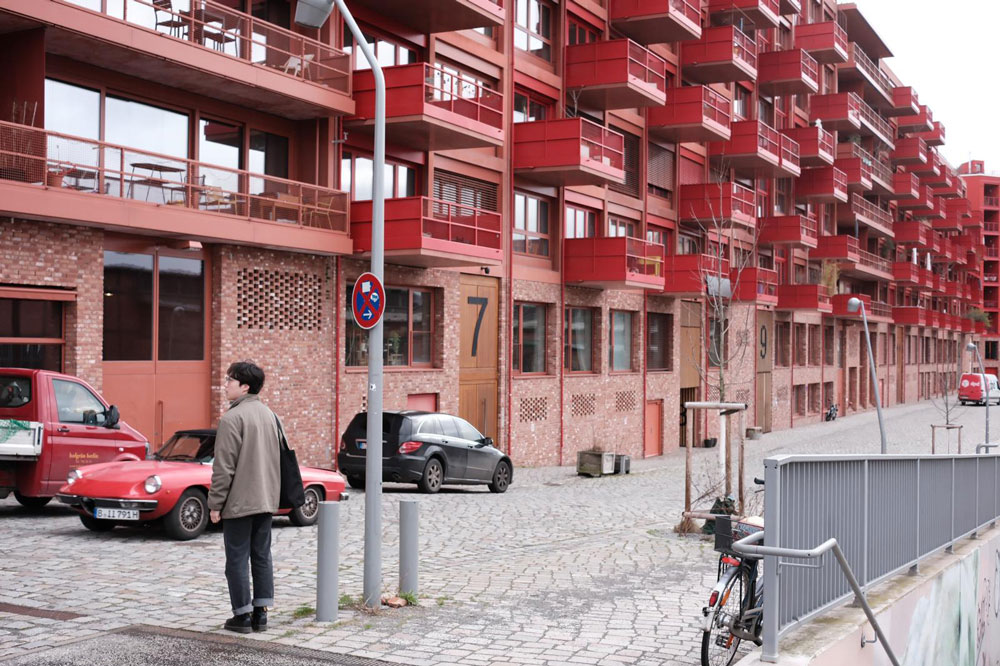
Despite having studied maps of the site and the city in the first part of the semester, Christopher Oh and Somin Lee (MAUD ’24) found that their experiences walking around Berlin brought home why Stubbergaard had chosen this city in particular. “In Berlin [adaptive reuse] is part of the culture,” said Oh, “but it didn’t come from a climate perspective.” Rather, it was a financial necessity after the war. Their eventual project proposed reuse of over 60 percent of the existing buildings on their section of the site, which connected the airport to the canal via a long strip, to provide housing; meanwhile, they added green spaces to promote community agriculture and pedestrian connectivity.
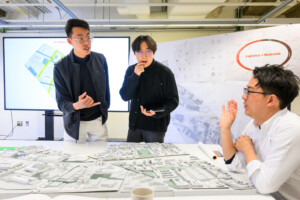
Gyu-Lee Hwang and Hui Li (both MAUD ’25) proposed relocating a mixed-use development currently being developed on the site of the Tempelhof airport to the former industrial area along the Teltow Canal. They explained, “Berlin is well known for applying mixed-use developments, but still they have this kind of zoning – residential and industrial [are] separated. Our site is located to the south of the Tempelhof airport along the Teltow canal. It’s very historic and is open to the public now. But they have this plan of using that green space to develop the housing because they have this population growth [projected to increase by nearly 200,000 inhabitants by 2040] and housing shortage problems.” They were inspired by the time they spent on their trip observing Berlin’s Höfe, linked courtyards that can be used as parks, playgrounds, retail businesses, or other community spaces for the residential housing that surround them. Hwang and Li proposed to turn the existing airport parking area into a series of Höfe.

As Stubbergaard noted in his talk, the construction industry accounts for 40 percent of the world’s greenhouse gas emissions, 60 percent of resource consumption, and 40 percent of waste generation. Stubbergaard believes that adaptive reuse is an ideal tool to help mitigate these problems. Indeed, more than 50 percent of Cobe’s current projects involve adaptive reuse on some level. The growing impact of adaptive reuse on the design fields has made students eager to learn about the topic as well. Christopher Oh says that “[Adaptive reuse] is definitely going to be a huge part of the profession in the future. I feel that there’s a huge push not just amongst us as students, wanting to engage more with it, but also people working in governments.”

The lessons that Stubbergaard and Cobe learned in their ongoing project of rebuilding the Nordhavn district are ones that he has tried to help the students apply to their Tempelhof sites. Like the reimagined Nordhavn, the studio projects prioritize pedestrian access and intersperse green space among residential areas, cultural and community space, and businesses.
Pete Walker & the GSD: Nearly 70 Years of Connections
For almost 70 years, the landscape architect Pete Walker (MLA ’57) has maintained strong ties with the Harvard Graduate School of Design (GSD), a relationship that has evolved alongside his career, from student to world-renowned designer and GSD benefactor. Since 2004, the Peter Walker & Partners Fellowship, conferred on Class Day, has supported travel for promising Landscape Architecture graduates.
Walker’s introduction to the GSD dates to the mid-1950s when he was a graduate student at the University of Illinois, studying with the landscape architect Stanley White. After his first term, Walker asked his professor what courses to take the next semester. White’s response? “Well, you’re not going to be here,” Walker recalled. “You’re going to be at Harvard.” Indeed, White had arranged with his former student Hideo Sasaki, then a GSD faculty member in the Department of Landscape Architecture, for Walker’s transfer.
Encouraging Walker’s move east, White had characterized Sasaki as a mastermind—an assessment Walker would soon share. “Sasaki saw the future in a way that I had never even imagined,” Walker says. “He gave this view of the world—an incredibly dynamic postwar view, talking about transportation, expansion of education, corporate expansion, urban expansion, world trade, airplanes. . . . I had never thought of landscape in those terms, likely because no one had really described it like that. And Sasaki was just beginning to.” Walker was thus exposed, though his time at the GSD and in Sasaki’s office, to a perspective that broadened landscape architecture’s reach to an urban scale.
Walker graduated from the GSD with an MLA in 1957 and, funded by the school’s Jacob Weidenman Prize, undertook his first trip to Europe to visit the continent’s historic gardens. After returning home, he continued to work with Sasaki, cofounding Sasaki, Walker, and Associates (eventually the SWA Group), which soon added to its initial location in Watertown, Massachusetts, an office in San Francisco, with Walker at the helm. He left SWA in 1983, establishing a small practice with his then-wife and partner Martha Schwartz (currently Research Professor in Practice of Landscape Architecture at the GSD). Since then, the firm has undergone a series of iterations culminating in Peter Walker and Partners, which now operates as PWP Landscape Architecture .
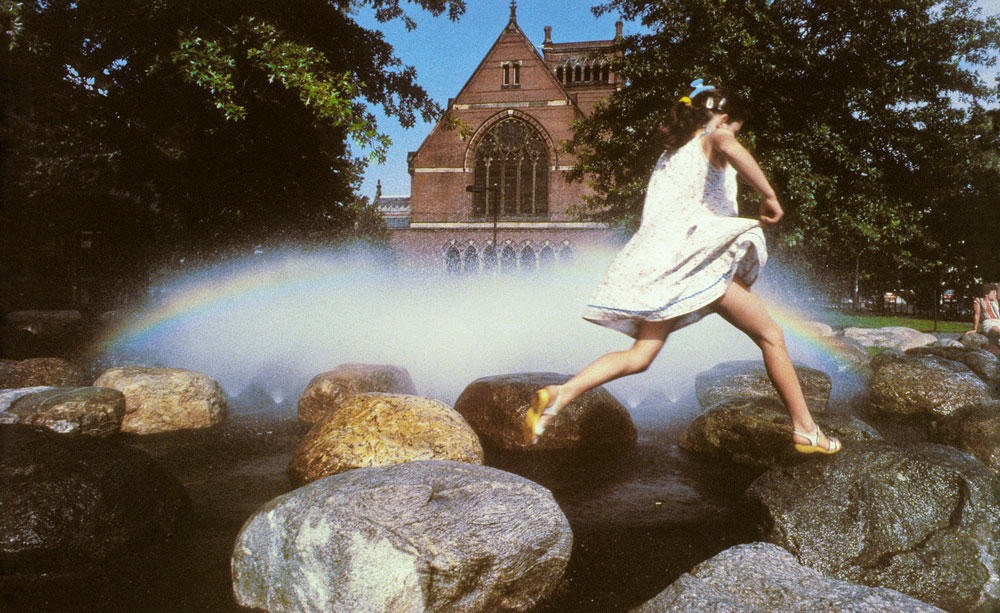
In the midst of celebrated design activity—including projects such as Harvard University’s Tanner Fountain (1984) and New York’s National September 11 Memorial (2011), with architect Michael Arad, and awards like the American Society of Landscape Architects (ASLA) Medal in 2004—Walker maintained a robust presence in the educational realm. While firmly ensconced at SWA in the mid-1970s, Walker returned to the GSD, initially as visiting critic and adjunct professor before serving as the acting director of the Urban Design program in 1976. (“My job was to replace myself,” Walker recalls. He succeeded, convincing his friend Moshe Safdie to become the new program head.) Walker then served as chair of the Department of Landscape Architecture from 1978 through 1981. He remained on the GSD’s faculty through 1991, after which time he moved on to UC Berkeley, his undergraduate alma mater, where he would lead the Department of Landscape Architecture and Environmental Planning in the late 1990s.
Despite Walker’s move to the West Coast and the subsequent passage of time, his presence continues to resonate at the GSD, especially through his former students, three of whom have chaired the Department of Landscape Architecture: Gary Hilderbrand (MLA ’85 and current chair), Anita Berrizbeitia (MLA ’87), and George Hargreaves (MLA ’79). Contributing another layer of connection, sons David E. Walker (MLA ’92) and Jacob S. Walker (MDes ’24) have cemented Walker’s position as alumni parent.
Finally, Walker has expanded his relationship with the GSD by becoming a benefactor. In 2004, his firm established the PWP Fellowship for Landscape Architecture to provide “young landscape architecture designers [with] an opportunity to spend a concentrated period of time studying landscape design in various parts of the world.” The roots of this annual award rest in Walker’s own post-graduate experience—namely his Weidenman Prize–sponsored European travels, which exposed him firsthand to a historical component of landscape design that complemented the modern perspective introduced by Sasaki. Walker sees the PWP Fellowship as an opportunity for emerging designers to further broaden their global outlook. “For me, in a sense,” Walker says, these graduates “represent what design could mean in a changing world.” This year Walker will attend the GSD’s Class Day for the conferral of the PWP Fellowship.

In various capacities, Walker has witnessed—and played a discernable role in—the Harvard GSD’s evolution. And from his unique vantage point, Walker recognizes the diverse, mind-expanding views amassed at the GSD as an enduring gift for students and alumni alike, even long after they have departed campus. As Walker notes, “through family and close friends”—many former students turned colleagues—“Harvard has kept me in touch with these things.”
Kongjian Yu Featured in the New York Times for his “Sponge City” Approach to Urban Floodwater Management
Among the challenges posed by climate change, floodwater looms large. Today, cities grapple with regular inundations brought by intensifying downpours and extreme weather events, and conventional approaches to stormwater management—drainage pipes, concrete channels, and the like—are proving insufficient. Landscape architect Kongjian Yu (DDes ’95) offers an alternative solution, one that welcomes the water rather than fights to expel it. Yu calls this concept the “sponge city,” an idea that has been applied in 250 Chinese municipalities since 2015.
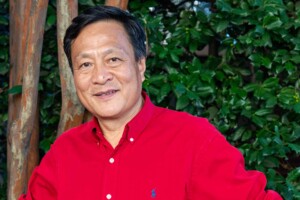
A recent New York Times article by Richard Schiffman, titled “He’s Got a Plan for Cities That Flood: Stop Fighting the Water,” details Yu’s sponge city approach and includes commentary by Niall Kirkwood, Charles Eliot Professor of Landscape Architecture at the Graduate School of Design.
In place of concrete drainage infrastructures, sponge cities embrace native vegetation, land formations, and constructed wetlands to slow and absorb excess water locally before it floods streets and subways. Such living landscapes offer additional benefits, as they simultaneously filter pollutants from surface water, provide habitats for wildlife, and offer recreational spaces for urban dwellers.
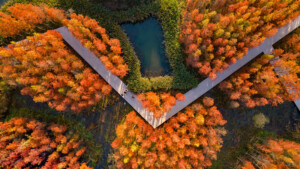
In September 2023, Yu delivered the Sylvester Baxter Lecture at the Graduate School of Design, “Adaptation: Political, Cultural, and Ecological Design—My Journey to Heal the Planet.” He discussed how his agricultural upbringing, experiences with the art of Chinese landscaping, and studies at the GSD inform his ideas about urban water management. The following month, the Cultural Landscape Foundation awarded Yu the 2023 Cornelia Han Oberlander International Landscape Architecture Prize (also known as the Oberlander Prize). Yu is founder of the Beijing-based firm Turenscape and professor at Peking University in Beijing.
From Drought to Flood: Solutions for Extreme Climate Events in Monterrey, Mexico
In 2022 and 2023, Monterrey, Mexico’s second largest city, experienced a critical shortage of water and, like Cape Town in 2018, was close to a Day Zero of water provision. The emergency made international headlines , as the state government rationed water for many of the city’s five million residents. While struggling at times to supply water to residents, Monterrey is also well-known for its severe floods that have peaked in intensity during deadly hurricanes, such as Gilbert in 1988 and Alex in 2010. In recent years the fluctuation between these extreme events has been intensified by a changing climate.
Like many other cities, Monterrey is not prepared for a warming planet with increased volumes of water in its atmosphere and extended droughts. The impervious urban ground that covers much of the city is designed to drain water as quickly as possible. Agriculture, industry, and citizens overexploit water unsustainably. As a result, during much of the year the Santa Catarina riverbed remains dry. Yet at times of heavy rain, it is prone to overflowing, with potential catastrophic results.
In the fall 2023 studio “AQUA INCOGNITA: Designing for extreme climate resilience in Monterrey, MX,” GSD Design Critic Lorena Bello Gómez worked with students to devise design strategies along the Santa Catarina watershed to increase water security and to reduce flood risk. Bello was invited to Monterrey after her work on the first iteration of AQUA INCOGNITA, in 2021 and 2022, which focused on the Apan Plains, a region that shares a basin with Mexico City and also struggles with its water supply.
For Bello, every studio is an opportunity to expose students to real-world climatic problems and inspire efforts to restore a lost balance with the water cycle. “Traveling with students for field research and engagement is a fundamental part of the pedagogy,” she explained. “The territorial scale of a project dealing with water risk in an urban region through the lens of an urban river, requires the ability to constantly telescope from macro to micro scales.” According to Bello, digital tools like Google Earth and Geographic Information Systems (GIS) cannot recreate the experience of “inhabiting and crossing the river with your own feet to understand its ecology and scale, and that of its surrounding infrastructures.”
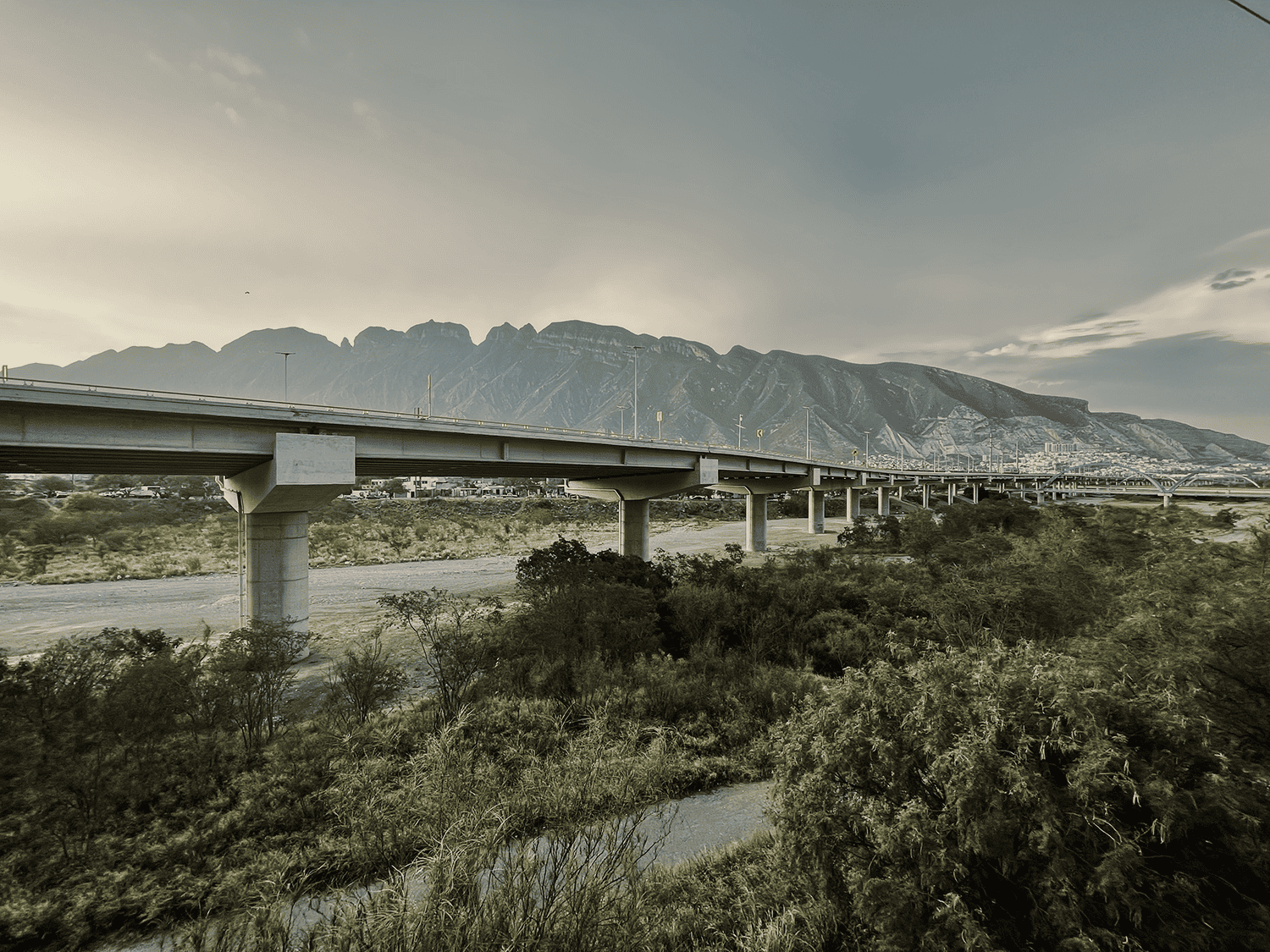
Bello’s focus on the Santa Catarina River watershed developed through a yearlong engagement with the regional conservation institution Terra Habitus , which sponsored the studio. In addition to giving students firsthand experience, Bello’s studio was also an opportunity to help those fighting to change the status quo on the ground. “Deciphering where to insert the needle in this impervious skin is the first incognita to solve,” Bello said. “We know that there is the potential to recover this river as an ecological corridor and climate resilience infrastructure for the city, but we also need to know that there are local academics, organizations, and citizens that could benefit from our work to push the political will.”
Bello’s fieldwork in advance of the studio included meetings with a variety of stakeholders. She gathered input from representatives of community groups and planning agencies as well as political leaders such as Monterrey’s mayor, Donaldo Colosio, and the mayor of neighboring San Pedro Garza García, Miguel Treviño. She also met with Juan Ignacio Barragán, the director of the local water operator Servicios de Agua y Drenaje de Monterrey. Other important preparation included a Spring 2023 research seminar, “Resilience Under New Water Regimes: the case of Monterrey Day-Zero”, supported by PhD candidate Samuel Tabory (PhD ’25).
Daniella Slowik (MLA II ’24) chose to take the studio because she is already focused on climate- and water-related projects and sees herself working on these topics after she graduates. “Different parts of the world are going to continue to experience massive extremes,” she said, “and we have to learn how to work within those constraints in our design field.”
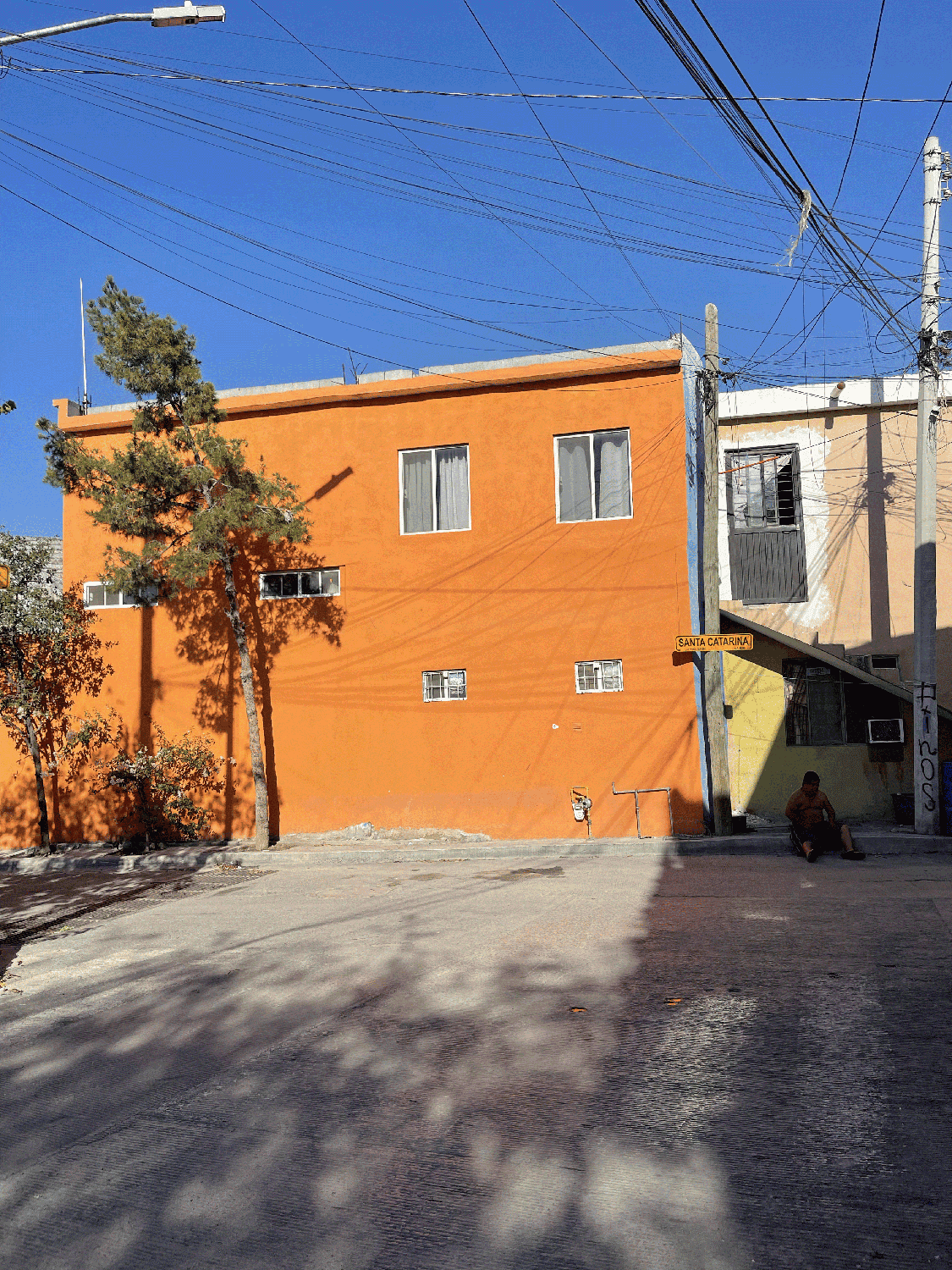
Students toured the riverbed with two local conservation groups as soon as they landed in Monterrey. They examined the soil and plant life in a dry section of riverbed running along one of Monterrey’s major highways before visiting Los Pinos, an informal settlement along the river. Locals shared memories of playing soccer, riding motorbikes, or attending parties on the riverbed, but they also expressed their new understanding of the river as a unique healthy ecology in otherwise desertifying Monterrey. The value of being on the ground, as Bello said, was in “sensing citizens’ empathy towards its river when they walk with us, learning about agricultural practices in the mountains, or understanding from local experts on policy and cultural challenges to overcome.” She continued, “This physical and personal exchange propels students’ imaginations, while their questions make locals aware of hidden aspects that they were overseeing.”
The group later drove to La Huasteca, the first canyon in the Parque Cumbres National Park in the nearby mountains that is the source of the Santa Catarina. The area has also become a site of unregulated settlements despite its protected status. “Traversing the lengthy river,” Bello explained, allowed students to “understand the duality between its urban condition downstream—today a flood-control channel—and its powerful upstream condition along the monumental Huasteca and Cumbres National Park, or by its flood control dam Rompepicos.”
The studio also spent several days participating in the Urban Hydrological Adaptation symposium and workshop sponsored by the Tecnológico de Monterrey with GSD former graduate Ruben Segovia (MArch II ’17). Organized by Bello and Segovia, the gathering of architects, landscape architects, and other academics built on conversations she had at the Tec de Monterrey on her previous fieldwork visits. Over the course of several days, students presented case studies of other cities with rivers that they had prepared earlier in the semester.

Several afternoons were devoted to site visits to locations ranging from parks such as the upscale Paseo San Lucia, an artificial canal offering boat rides, to Centrito, a neighborhood in the process of being rebuilt, where the group navigated several blocks of construction sites in 95-degree heat. A highlight that was both fun and educational was a hike in Chipinque National Park, which offered breathtaking views of the Sierra Madre Oriental and the ability to view the city within the context of the mountain landscape.
Inspired by the knowledge gleaned from the site visits and motivated by meetings with representatives from the municipalities of Monterrey and nearby San Pedro to address urgent needs, students’ final projects displayed a variety of alternative futures for the Santa Catarina River. While working individually, they also tackled collectively the myriad of challenges to overcome at the Rompepicos flood control dam, at the Cumbres National Park, and along the Santa Catarina River from the Cumbres to the urban park Fundidora. The final projects displayed a wide variety of solutions. Some students chose to center their work on the mountainous area around La Huasteca; others took as their focus the highways or parks closer to the urban center. (See an overview of the projects below).
As climate change becomes an unavoidable concern in the design disciplines, the GSD’s Department of Landscape Architecture has pledged its “abiding commitment to climate mitigation and adaptation through its curriculum, faculty research, and design culture.” Indeed, many students cited the urgency of climate change as a primary reason that they chose this particular studio. Bello’s career has also focused on climate. In addition to her previous research in Mexico, she has used her background in landscape, architecture, and urbanism in her work with environmentally vulnerable communities in India, Colombia, and Armenia. Weather permitting, she says with a smile, she plans to expand the Monterrey studio next fall.
For the final review, students presented their work in a sequence arranged geographically along the river transect, presenting the different challenges and opportunities to overcome by design such as:
Reciprocity at Cumbres National Park
- Jianing Zhou (MLA II ’24)’s project proposes an alternative network of almost invisible “incognito dams” as a counterpoint to mega-projects meant to control flood risk
- Emily Menard (MLA II ’24) explores reciprocal relationships between those who visit and inhabit the park, towards a more mutualistic and regenerative land use for water conservation
The ephemerality of flooding
- Lucas Dobbin (MLA I AP ’24) created “room for the river” at a key bend and point of risk inflection for extreme water flows entering the city from Parque Cumbres
- Pie Chueathue (MLA II ’24) uses the time in between floods to introduce a temporary/light-footprint tree nursery to promote urban tree canopy and work
Vertical and horizontal capillarity
- To reduce flood risk in the larger watershed, Boya Zhou (MLA I AP ’24) proposed starting to recover the network of streams while reconnecting them to the urban fabric
Circularity
- Responding to the near-shoring boom in Monterrey, Sanjana Shiroor (MAUD ’24) explored principles of circularity for brownfields along the river’s corridor to counter low-density sprawl
Bridging and descending to bring the edge of the city to the river
- Ashley Ng (MLA I ’24) designed a promenade
- Sophie Chien (MLA I AP/MUP ’24) proposed an inhabited bridge
- Using bridges as a river entrance to descend to a newly terraformed riverbed, allowing for habitat and inhabitation between storms, was the design vision of Annabel Grunebaum (MLA I ’24), Miguel Lantigua Inoa (MArch II/MLA I AP ’24) and Bernadette McCrann (MLA I AP ’24)
Climate justice
- Daniella Slowik (MLA II ’24)’s project emerged from a deep engagement with the history of Independencia, a marginalized community near the river, and asked what it would mean to convert the river into a community asset rather than just a source of vulnerability and risk
How Public Health Methods Can Bolster Socially Conscious Urban Development
Cities today are faced with complex challenges that require careful decisions about the future of the built environment. Development projects hold the potential to strengthen communities by helping to combat inequality, repair a legacy of environmental racism, improve health outcomes, and adapt to a changing climate. Developers, designers, and city officials alike need sophisticated tools and methodologies to ensure that projects can positively impact their communities while meeting the needs of all stakeholders.
In cities such as Boston, public review processes already exist that aim to foster conversation about the costs and benefits of new development; however, these processes can be slow and contentious. The field of public health offers new tools and insights that can help city leaders, community members, and designers understand the full range of impacts that a given project might produce. Adele Houghton , president of Biositu LLC and instructor at the Harvard T.H. Chan School of Public Health, has been working to bridge these fields for much of her career, most recently by applying a technique known as health situation analysis to real estate development. While pursuing a doctorate at the School of Public Health, Houghton collaborated with Matthew Kiefer, Lecturer in Real Estate at Harvard’s Graduate School of Design. Their work resulted in the recent article “How Real Estate Development Can Boost Urban Health, ” published in the Stanford Social Innovation Review.
Houghton and Kiefer spoke with the GSD’s William Smith about how health situation analysis can be a tool for aligning with the needs of communities, the business aims of real estate developers, and the mandates of city agencies charged with overseeing equitable development.
How did this project come about?
Matthew Kiefer The article grew out of a collaboration between Adele and me in a class I taught at the GSD last year called Developing for Social Impact. The premise of the course was to harmonize purpose and profit in real estate development and harness economically feasible projects to accomplish social and environmental goals. We used active Boston development sites as case studies, and student teams working on one site got very interested in the health situation analysis that Adele introduced.
Adele Houghton I reached out to Matthew because I was interested in the dual business model he presented through the course. I was a Doctor of Public Health (DrPH) student at the time, studying at the T.H. Chan School of Public Health. The DrPH degree is designed for mid-career professionals who want to translate research into action in the field. In my case, as an architect who has specialized in green and healthy building for about 20 years, I returned to school to learn how to apply public health methods to the design and real estate development process.
In architecture school you spend a lot of time learning about design, building codes, building engineering, and building systems. The business side is focused on how to create a firm; I wish I had learned more about real estate development. As part of my DrPH, I wanted to learn more about how real estate development happens: how you choose a site, how you decide what its highest and best use is, how you finance it. Matthew’s course did that—and brought environmental, social, and governance (ESG) considerations into that financial calculation.
How does public health relate to real estate development?
AH The work we do as architects and developers affects not just the people inside the building, but also the surrounding neighborhood. Our colleagues in the urban planning and community planning departments are learning about those systems, but architectural design often focuses exclusively inside the property line.
When I pivoted to studying public health about 15 years ago, it was to learn more about methods and data sets that would allow architects and developers to fill in some of the gaps in the site assessment process. I wanted to look not just at how a project site connects to utilities, or whether we need to include a sidewalk along the edge of the site, but really at how a site leverages its surroundings to create a positive ripple effect in the community.
The core of your method is health situation analysis. Could you explain what that entails?
AH The methodology takes data sets and makes them actionable by providing design strategies that a developer or an architecture team could use in response to the conditions in the surrounding neighborhood.
Health situation analysis is already used by local health departments to assess what’s going on in a community and create an evidence-based plan for what to do about it. For example, the Covid-19 pandemic started in clusters around the country. We weren’t sure what it was. We weren’t sure how it was going to impact the community. We didn’t know who was going to be most impacted. Health situation analysis allowed local health departments to understand what was happening and make best use of their resources by implementing the smallest number of interventions—while ensuring that those interventions were not in conflict with each other.
We regularly do site assessments at the start of every design and real estate project. By incorporating health situation analysis into that process, we can pull together data sets to understand the demographics on and around the site, the environmental conditions, and the prevalence of underlying health conditions. For example, an elderly person exposed to a heat wave or power failure is at higher risk of going to the hospital than a younger, healthier person. Health situation analysis helps us tailor the design of an individual real estate project to support the health needs of vulnerable groups inside the building and in the surrounding community so it can have the biggest possible positive impact across multiple priorities–whether environmental, social, or financial.
What kinds of data sets do you look at?
AH When we perform a health situation analysis, we sift through publicly available data sets and look for trends in an entire population–whether inside the building or in the surrounding neighborhood.
We can divide the data sets we look at into three different groups. The first is called social determinants of health: factors outside a person’s own body that can influence their health. Most of that data comes from the US Census. Some people in our community are at higher risk of negative health outcomes because of their age—particularly young children and the elderly—or because they have less robust immune systems, such as cancer patients. We particularly assess factors related to how our society is set up—such as differences in access to health care, to clean air, to education, and healthy housing across income levels and the legacy of racist land use policies like redlining. Over time, those differences lead to disparities in health outcomes, and even in life expectancy. The social determinants of health help us understand which groups of people in the building and surrounding neighborhood are more likely to have a negative health outcome, say, if they’re exposed to a lot of air pollution, heat, or flooding.
The second category of data is community health indicators that are influenced by the built environment—such as asthma rates, cancer rates, mental health, and obesity rates. Every year, the Centers for Disease Control and Prevention (CDC) conducts representational surveys at the national level and then creates estimates at the census-tract level about the prevalence of those health risks.
The third data set relates to the health effects of climate change, and that’s mostly taken from an index created by the Federal Emergency Management Agency (FEMA). It combines a list of about a dozen natural disasters with social determinants of health to analyze the vulnerability of a census tract to each hazard.
Combining these three types of data sets, we end up with a mosaic picture of a neighborhood’s current health conditions and potential risks that could be modified through design.

The paper describes three components of a design process that includes health situation analysis. You define these as data analysis, community engagement, and cost-benefit analysis. How do these aspects fit together?
MK Our article applies this methodology to the public approval process that every real estate development goes through. The larger the development, the more rigorous the approval process and the greater the opportunity to affect public health positively or negatively. Health situation analysis helps you understand how all the publicly available data applies to your site. That leads to decisions about how to design your project. And it can lead to changes in everything from building design, to programming, to mitigation commitments surrounding your site.
Health situation analysis is also a useful way to frame communications with neighbors and with community members who participate in the approval process, allowing you to explain why you’re designing the project the way you are. We use the example of a building that has reduced carbon emissions to adhere to a city-wide net zero mandate. If I’m living a block away, how much do I care about that city-wide mandate? But if there are high asthma rates in the neighborhood, and maybe my child has asthma, then the effect of the project on asthma rates might be a better frame for helping me evaluate the project. Health situation analysis is a way to ground those community discussions that every real estate development project has anyway in data that is specific to the neighborhood and informs the community engagement process.
Of course, the real estate developer’s primary objective is not to address public health in the neighborhood; it’s to develop a feasible project and in the process take prudent measures to address public health effects. How do you figure out whether given measures are sensible when you’re trying to harmonize those two objectives? Cost-benefit analysis is the standard way to do it. How much is it going to add to the capital or operating cost of the project and what benefits will it produce, even if those benefits flow to others?
It may be that the developer bears the cost while the benefits flow to the neighbors. But, if the developer is trying to make the case for density on the site, for public approvals, for financing from mission-oriented investors who care about social impact, then health situation analysis is a useful mechanism to test the efficacy of the measures the developer is proposing.
AH What you’re doing inside the property line is creating value beyond the property line. Health situation analysis helps expand the value proposition and answer the question: How could the developer and the design team benefit from providing benefits to the surrounding community?
How do you see health situation analysis mitigating broader housing problems specifically?
AH I’m talking right now to two city housing authorities that are interested in the idea of health situation analysis. They’re thinking about how a development project fits into larger systems, whether they’re environmental systems, social systems, or economic systems.
They consider questions beyond design and construction, such as: What do you do after the building is constructed? How is it operated? A lot of the benefit to the community happens after the building is operational. Affordable housing has to be an affordable place to live once you’re in it. It also has to be well-maintained with amenities like childcare facilities, a playground, maybe even a pharmacy or a primary care facility. We can’t think about housing as just the dwelling. It needs to be thought of as fitting into a larger system. Health situation analysis allows for that conversation to happen in a structured, data-driven way.
MK You could apply the health situation analysis methodology to any kind of project, but it’s particularly powerful for housing. In Boston and many cities with strong economies, housing attainability is a significant issue for many households. In Boston we’re creating jobs faster than we’re creating housing units for the people who are taking those jobs. That drives up prices for middle-income households, young families, first time home-buyers. Health situation analysis doesn’t solve that problem, but it can help overcome barriers to housing production by situating the public review and community-engagement processes in an evidence-based framework that communicates how a project is going to benefit a neighborhood. If this were adopted more broadly, it could help to ease the production of more housing to satisfy rising demand.
Your paper focuses on a case-study development site in Boston called P3. How were you able to apply the health situation analysis method in that instance?
MK P3 is a large publicly owned site in the Roxbury neighborhood of Boston. It was cleared in the urban renewal era and has sat mostly unused ever since. It’s near Nubian Square, the heart of Boston’s African-American community, and across from a major transit node. The Boston Planning and Development Agency was doing a development competition—they’ve since designated a developer. So it was a fruitful case study site in my Developing for Social Impact course.
AH Boston is a great place to do this kind of project because it has an open data portal that has information on a wide range of topics related to the environment, social services, and demographics as well as a lot of qualitative information—interviews with residents in the Boston area. But the data sets are not interconnected. By doing the health situation analysis for P3, I was able to explain how that particular parcel situated within its census tract in Roxbury could help the city or at least the neighborhood address its high vulnerability to heat and its high vulnerability to flooding. The corner of the site is also located at an intersection with a high incidence of pedestrians and cyclists being injured by cars. It’s a place where a lot of elements intersect, but their relationship with each other is not obvious if you only look at each set of information separately.
The students in Matthew’s course picked up on how important it is to see the larger system. Matthew also made sure that the students had access to community members representing residents as well as businesses and institutions that were important in the neighborhood. There’s a real concern in Roxbury about displacement. The health situation analysis and conversations with the community helped students answer the question: How do you redevelop this important large site in a way that is responsive to the needs of the people that are already in that neighborhood, and help to bring jobs and economic opportunity and additional housing for them, while also recognizing that this could be an economic draw for other people in Boston?
Beyond the classroom, how have you been able to translate health situation analysis into real-world action?
AH I’ve been consulting throughout my career at Harvard. My dissertation, which was funded through the AIA Upjohn Research Initiative, was a proof-of-concept pilot working with three active real estate projects: one in Albany, New York; one in Buffalo, New York; and one in Waterford, Virginia. The health situation analysis is part of a larger engagement I call The Alignment Process, which uses health situation analysis as the first step in a multi-stakeholder conversation seeking common ground across three groups who often do not see eye to eye in the development process: the real estate development team, neighborhood residents and businesses, and local officials.
At the end of the process, stakeholders from all three pilots had co-developed aligned visions for their projects, as well as supportive design strategies. The process also produced metrics that the different stakeholder groups could use to keep track of the project and hold each other accountable to the actions to which they had committed to make sure that the project would achieve the agreed-upon vision.
One of my goals coming out of the pilot is to train designers, real estate professionals, local officials, and community groups so that The Alignment Process, and health situation analysis specifically, become standard practice. To that end, I have released a playbook walking stakeholders through the process step-by-step. With funding from the Boston Society for Architecture, Caroline Shannon (another GSD and Harvard Chan alum), and I recently ran the first two train-the-trainer workshops on this topic in Massachusetts. I’m also actively fundraising to turn the process of generating a health situation analysis, the data part of The Alignment Process, into an automated tool so that any designer, real estate team, community group, or municipality could make use of this approach.
MK One of the great virtues of the tool is that it brings stakeholders together. I sometimes describe the public approval process as a three-legged stool. The first leg of the stool is the proponent: the real estate developer or sponsor of the project, whether for-profit or nonprofit. Community stakeholders are the second leg of the stool. There are many community stakeholders and they have different viewpoints, but all of the outside parties affected by decisions about the project are part of the approval process. And the third leg of the stool is the public agency that approves the project. We try to make clear in the article that The Alignment Process generates benefits for all three of those legs of the stool.
It may be most obvious how the community members would benefit from health situation analysis. But project sponsors can also benefit by using it as an organizing framework for their mitigation decisions and discussions with project neighbors. It helps rationalize the approval process and can also benefit the way they do business and build relationships with their lenders and investors as well as their neighbors beyond the project.
The public agency also benefits. The approval process is often very contentious and it’s ultimately the public agency that needs to make a decision about whether to issue a permit. We live in a time of eroding faith in government as an effective agent of positive social change. In this environment, The Boston Planning and Development Agency—the agency most involved in development decisions for large projects—is eager to reach a successful resolution of development approvals, both so that worthy projects go forward, and to demonstrate its own effectiveness as an arbiter and decisionmaker on behalf of Boston’s citizens.
GSD How did the GSD facilitate this research?
AH It was an incredible experience for me as both an architect and doctoral student at the School of Public Health to be so welcomed at the GSD and basically recruited by Matthew as both a student and a teaching fellow in the course. The faculty here recognize their students’ strengths and the fact that so many students are experts in fields outside of design. They see that there’s an opportunity to incorporate broader fields of knowledge into the discussion around design. My more recent research on transdisciplinary curricula at the intersection of climate change, health, and equity reinforced my personal experience in Matthew’s course. There are very few schools that can provide this level of transdisciplinary education, and Harvard is at the top of the list, both in terms of having that capacity and actually starting to use it.
The Forest for the Trees (and the Birds, and the People, and the Planet)
As we continue to face the twin crises of rapidly accelerating climate change and biodiversity loss, city leaders and city residents are especially feeling the heat. The increasingly desperate need to radically cool cities is becoming widespread news , and the appointment of chief heat officers in cities as widespread as Athens , Miami, and Freeport, Sierra Leone , is a testament to the urgency of the issue. Many factors contribute to both the climatic challenges and the loss of biodiversity in cities (including, simply, the construction of buildings and streets), but one solution stands out: trees.
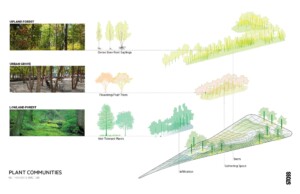
Trees are known for their inherent ability to provide shade, and therefore to cool the environment. In many cities generally, and especially in urban neighborhoods with predominantly Black, Brown, multi-ethnic, and socially vulnerable communities, the pervasive lack of a healthy tree canopy contributes to soaring temperatures and negative public health outcomes. This is just another way in which lower income, racially and ethnically diverse communities (often referred to as “environmental justice communities”) are impacted more significantly by the multiple effects of climate change.
The absence of trees also contributes to an increasing loss of ecosystem biodiversity and wildlife habitat, which in turn has detrimental effects on the environment as a whole (both in cities and beyond). And, with few or no trees in urban spaces, we reduce the opportunity to sequester carbon, to clean the air and the soil, to mitigate stormwater flooding, and to sustain healthy habitats for birds and other creatures–all critical functions of trees in healthy ecosystems–thereby exacerbating both the effects of climate change and the impacts of social and racial inequities.
Boston and Cambridge, along with many cities around the world, have recently developed their own urban forestry master plans to reverse these negative effects. They are creating new urban forestry divisions and leadership that will oversee implementation–including both care of existing trees and cultivation of an expanded tree canopy specifically adapted to tough urban environments. In many other places, like Los Angeles, city governments are partnering with educational institutions, non-profit organizations, and professionals to develop metrics-based, neighborhood-specific plans for the most impacted communities, from both environmental and social standpoints. In Dallas–Fort Worth, the non-profit group Texas Tree Foundation has been raising philanthropic dollars to fund and oversee the installation of tree plantings, advise on urban forestry plans in various cities in the region, and set up new training opportunities in the green labor force for those coming out of prison and looking to gain new skills and move on with their lives. Additionally, new “microforestry” efforts (also known as Miyawaki Forests) that dramatically increase species biodiversity in very small urban footprints are finally making their way from around the world into American cities and even into news coverage by the New York Times .
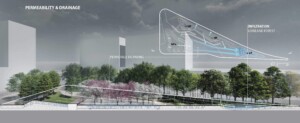
Most recently, as of the last week in September, Cambridge has its first urban forestry demonstration project at Triangle Park, in the Kendall Square neighborhood. The project is one of three small urban parks–two on “leftover” or underutilized parcels of land–that is meant to dramatically increase the amount and type of open space available to residents and workers in this part of the City. (My firm, Stoss Landscape Urbanism, was commissioned in 2016 to design both Triangle Park and the nearby Binney Street Park, which will open in 2024 as a park for dogs and people, while another Cambridge firm, MVVA, was commissioned to design the third park, Toomey Park, as a community gathering space and play area). Triangle Park in particular, was designated to embody the principles of the City’s urban forestry plan–in part as a test, in part as a demonstration–of this new commitment to trees, biodiversity, and innovative maintenance techniques tailored to this new mission.
“The design of this project was guided by the City’s Urban Forest Master Plan and includes significant tree plantings and canopy growth in the Kendall Square area,” said Public Works Commissioner Kathy Watkins. “It also allowed us to try some new approaches for how we think about open spaces and planting trees in the City. As the trees and plantings grow in over time, this unique park will provide an incredible shaded space in the heart of Kendall Square for residents and visitors to enjoy.”
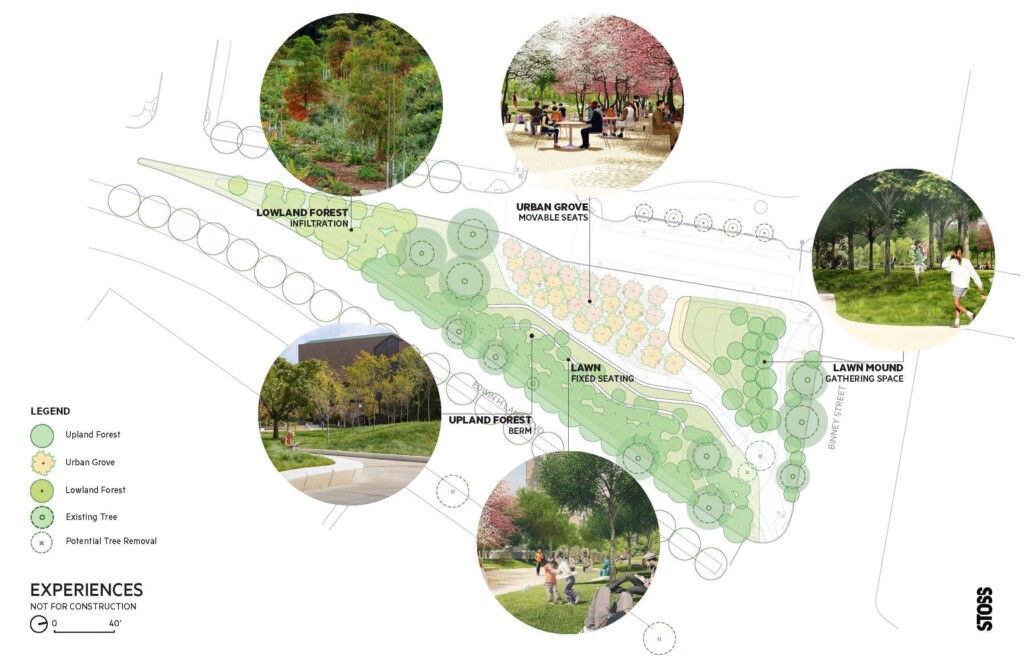
The site itself is small (three-quarters of an acre) but complex. At various times in his history, it was a tidal mud flat at the mouth of the Charles River, a fueling station, a parking lot for trucks, a dumping ground for urban debris, and an empty traffic island. It continues to be surrounded on all three sides by vehicular traffic–to the east and north by busy and noisy four-lane arterials, and to the west by a smaller connector street with an active retail/restaurant frontage. All this presented a series of challenges for transforming a compacted site with urban fill and contaminated waste to a healthy and thriving ecosystem that could support the growth of trees, shrubs, and groundcovers, and become the new center of the nearby community. These are challenges that were ultimately overcome by an extensive and collaborative team comprised of landscape architects, ecologists, arborists, maintenance specialists, environmental engineers, and others that are a combination of both city staff and hired consultants.
The design responds to these conditions and seeks to create a new space for trees and people to intermingle in a dense urban neighborhood. A berm along the eastern edge of the park marks the eastern edge of the site and screens the traffic and noise from Edwin Land Boulevard, allowing for elevational differences that enhance both social and environmental opportunities. On the back and top, it is planted with a variety of native upland trees and plant species (shagbark hickory, black oak, hackberry) in dense thickets that are designed to grow rapidly and to allow for natural competition and succession–an innovation in urban parks like this, one that requires an intense level of ongoing care and maintenance for which the City has committed resources and expertise. The inner side of the berm is inscribed with terraced lawns and linear seating walls, creating a welcoming and active social edge at the heart of the space–perfect for socializing, sunning, or reading. On the north, a lawn slope and stage are backed by woodland varieties and border forest floor (including American hornbeam, American smoketree, arborvitae, Eastern hayscented fern); these, too, screen out some of the noise and visuals of the nearby traffic but also create distance from the street to allow for more casual sunning, play, and performance activities. The very south end of the site–where the triangle comes to a very sharp and dramatic point, the earth is excavated to collect the site’s stormwater (a kind of green infrastructure stormwater “sponge”) and is overplanted as a lowland forest of Dawn Redwoods and a variety of birch species with an understory of ferns and witch-hazel. This feature even twenty years ago would have been non-existent, as conventional engineering techniques would have relied on pipes and infrastructure to flush the water away; here, instead, we deliberately retain the water on site into order to create ecological diversity and an environmentally healthy space. Finally, the central plaza–designed with a dramatic but abstracted parquet floor motif and rendered in white and black gravel–is populated with a combination of multi-stem River Birch and Kentucky Coffeetrees, which will provide a unique and richly shaded and flexible setting for people on scattered cafe table and chairs.

In all, the park includes almost 400 new tree plantings and introduces 15 new tree species to the collection of eight trees and four species already on site. This is quite remarkable on a site that measures just over three-quarters of an acre with a variety of spaces reserved for people and activities!
In a burgeoning neighborhood with very low levels of open space and urban canopy, this small city forest is impactful–and the social and environmental benefits will continue to grow and intensify over time, just as the trees themselves grow and take on wonderful shapes and characters. Equally important as these direct effects, the project is intended to serve as a test case and model for how the City of Cambridge implements its Urban Forestry Plan –and how cities across the country and around the world can benefit from what we learn moving forward. More tests and demonstrations like this are needed–so that we can collectively see how these projects mitigate and reverse the effects of climate change and biodiversity loss we are seeing now–and how cities can re-tool their own staffs and maintenance practices in order to better cultivate and care for these leading-edge, research-in-practice projects.
“Plains and Pampa: Decolonizing ‘America,’” by Ana María León Crespo—Excerpt from Harvard Design Magazine
It is a common trope for scholars from South America, Central America, and the Caribbean to argue that America is the continent, and not the country. It is less common to consider what the idea of America as a territorial unit might imply. Thinking about the region as a whole prompts us to notice similar processes and shared politics, particularly in reference to decolonization and decolonial discourses.[1]
Indigenous scholars in settler colonial countries such as Australia, Canada, and the United States have advanced theories of decolonization as the rematriation of Indigenous land and life. [2] In contrast, Latin American decolonial theorists—known as the Modernity/Coloniality group—have focused their critique on the role of colonialism in the construction of modernity.[3] Both terms stem from the discourse on resistance and struggle by Martinique intellectuals Aimé Césaire and Frantz Fanon, whose argument cuts across these groups and highlights the role of Black studies within both—a complicated intersection that I’m unable to address in this piece. [4]
Given the increased use of these terms, it is important to understand the slippage between decolonization and decoloniality, which have in many cases been conflated. More urgently, both concepts have often been reduced to apolitical notions of increased geographical coverage, eloquently summarized by Anni Ankitha Pullagura as the notion of “making empire more inclusive.”[5] Rather than cede ground to this depoliticized inclusion, the challenge in thinking through the idea of decolonizing “America”—or any territory for that matter—is that of centering the voices excluded by empire. Land and its inhabitation, occupation, or possession plays a key role in this conversation. The way we situate ourselves within it has the potential to redefine the history of architecture as well as architecture itself.
Decolonization points to the impact of settler colonialism—a type of colonialism in which the Indigenous population is replaced by an invasive settler society. Meanwhile, decoloniality is less geographically determined, and seeks to critique colonialism as an epistemic framework whose violence is present in all locations, even in colonizer regions. In doing so, decolonial theory can sometimes place too much emphasis on Eurocentrism, eliding the internal conflicts highlighted by what decolonization theory describes as the “entangled triad structure of settler-native-slave.” [6]
Thinking through this structure, decolonization points to the multiple ways in which the development of settler colonialism—in countries such as the United States but also, I argue, Argentina—is enmeshed in processes of capital extraction that have racialized populations and depleted the land. Complementing this discourse, decoloniality reveals the ways in which these processes are constitutive of modernity itself, understanding the European arrival to America as a component of the acceleration of global commerce that links modernization, capitalism, and empire.
A brief example highlights how comparing these different histories through these combined theoretical frameworks can reveal some blind spots. The independence movements in both the US and Argentina were led by European descendants eager for political independence from Europe and more economic power. While in other countries Indigeneity was strategically appropriated in the formation of national identity (particularly in countries with monumental Indigenous architecture, such as Mexico and Peru), in settler colonial societies Indigenous peoples were seen as a threat to the construction of the nation.[7] Thus upon gaining independence, both the US and Argentina targeted the Indigenous populations that inhabited what they conceived as their land, resulting in a series of extermination campaigns with the specific objective of appropriating Indigenous territory.
Human and non-human agents have inhabited the continent for millennia, benefitting from mutually sustaining relationships. The aggressive hunting of the bison in the US, and the introduction of non-Indigenous species such as cattle and swine in both countries, radically transformed this landscape.[8] The replacement of local staples with more profitable, non-Indigenous crops echoes the aggressive replacement of Indigenous people including Anishinaabe groups in the north and Mapuche, Aymara, and other groups in the south. Taken together, these are the processes of settler capitalism, the primary goal of which is the transformation of land into a site of extraction. The role of the US Plains and the Argentinian pampas in the construction of these countries’ national identities highlights how the mythification of the land is a component of its commodification. These and subsequent histories of land dispossession, occupation, extraction, and capital constitute our American modernity.
Decolonization points to the status of America as occupied land, and decoloniality reveals the role of this occupation in the production of modernity. Understanding the intersection between the two allows us to turn toward new relationships with the land—relationships that might dismantle settler frameworks and center previously silenced voices. While decolonization and decoloniality have different, overlapping definitions, it is their shared politics that suggest a different approach to land and its history. Nick Estes, historian and citizen of the Lower Brule Sioux Tribe, titled his groundbreaking book on Indigenous resistance with the beautiful words Our History Is the Future. [9] Indeed, the histories we learn, research, and teach open up other futures. By studying the environments that peel away settler narratives of buildings and landscapes, we can open the way toward decolonized and decolonial futures.
Ana María León Crespo is an architect and a historian of objects, buildings, and landscapes. Her work traces how spatial politics shape the modernity and coloniality of the Americas. León teaches at the Harvard GSD and is cofounder of several collaborations laboring to broaden the reach of architectural history.
[1] The Decolonizing Pedagogies Workshop (2018—) and the Settler Colonial City Project (2019—), both co-founded with Andrew Herscher, have been key in understanding these topics. The students of “Histories of Architecture Against” (Fall 2019) at the University of Michigan helped me think through these categories. A longer, earlier version of this text was originally presented in Mexico City at the CIHU congress in Fernando Luiz Lara and Reina Loredo’s panel “Rompiendo Fronteras Coloniales.” I am thankful to their call to think about these histories.
[2] See Eve Tuck (Aleut) and K. Wayne Yang, “Decolonization is not a metaphor,” Decolonization: Indigeneity, Education & Society 1:1 (2012): 3.
[3] The Modernity/Coloniality group includes the work of Walter Mignolo, Aníbal Quijano, Ramón Grosfoguel, Arturo Escobar, Fernando Coronil, Javier Sanjinés, Enrique Dussel, and others. The project starts roughly in 1998 and includes both collective and individual books.
[4] Aimé Césaire, Discours sur le colonialisme (Paris: Éditions Reclame, 1950) and Frantz Fanon, Les damnés de la terre (France: Éditions Maspero, 1961). For more on the intersection between Black and Native studies see Tiffany Lethabo King, The Black Shoals: Offshore Formations of Black and Native Studies (Durham, NC: Duke University Press, 2019).
[5] Anni Ankitha Pullagura in the introduction of her recent CAA panel with Anuradha Vikram, “A Third Museum is Possible: Towards a Decolonial Curatorial Practice.” Collegiate Art Association Annual Conference, 14 February 2020, Chicago, IL. In working through these ideas I’m also indebted to Ananda Cohen-Aponte’s beautiful response to “Working with Decolonial Theory in the Early Modern Period,” CAA 13 February 2020, Chicago IL.
[6] Tuck and Yang, “Decolonization is not a metaphor,” 1. Silvia Rivera Cusicanqui has made an eloquent critique of the Modernity/Coloniality group from an Indigenous perspective. Silvia Rivera Cusicanqui, “Ch’ixinakax utxiwa: A Reflection on the Practices and Discourses of Decolonization,” South Atlantic Quarterly (2011), 111(1): 95-109. For a conversation across these differences, see “Thinking and Engaging with the Decolonial: A Conversation Between Walter D. Mignolo and Wanda Nanibush,” in Afterall: A Journal of Art, Context and Enquiry, no. 45 (Spring/Summer 2018): 24-29.
[7] This is not to say that Indigenous peoples have not been under attack in societies that do not strictly fit settler colonial frameworks.
[8] For an environmental history after settler occupation in New England, see William Cronon, Changes in the Land: Indians, Colonists, and the Ecology of New England (New York: Hill and Wang, 1983).
[9] Nick Estes, Our History Is the Future: Standing Rock Versus the Dakota Access Pipeline, and the Long Tradition of Indigenous Resistance (London: Verso, 2019).
This piece was originally written for, and printed in, Harvard Design Magazine #48: “America ,” 2021
Climate Migration: Latin America Prepares for an Increase in Environmental Refugees
Infrastructure, in conventional imaginations, exists as a tool of permanence: bridges, roads, sidewalks, and utilities are eternal public goods. Climate change has challenged that reality; extreme, less predictable climates have generated new discourses in adaptation and flexibility as core components of infrastructural resilience in the face of uncertain futures. Design Critics in Urban Planning and Design, Soledad Patiño and Felipe Vera are approaching the notion of adaptable, flexible infrastructure through the lens of climate-related migration. As researchers focused on vulnerable communities and environments in Latin America, their course, “Latin America in Transition: Imagining Infrastructures for Climatic Migration” is an opportunity for Harvard GSD students to explore potential systems and interventions that can prepare countries to receive an increasingly unpredictable flow of refugees.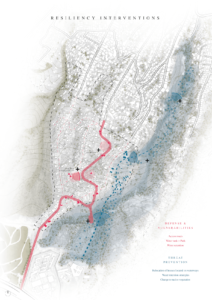
Map by Rolando Girodengo (MAUD ’23) depicting resiliency interventions for vulnerable settlements in the Chilean city of Valparaíso.
It is important to think of environmental immigration, not only as a shock and compulsive displacement of people, but also as processes.
Soledad Patiño
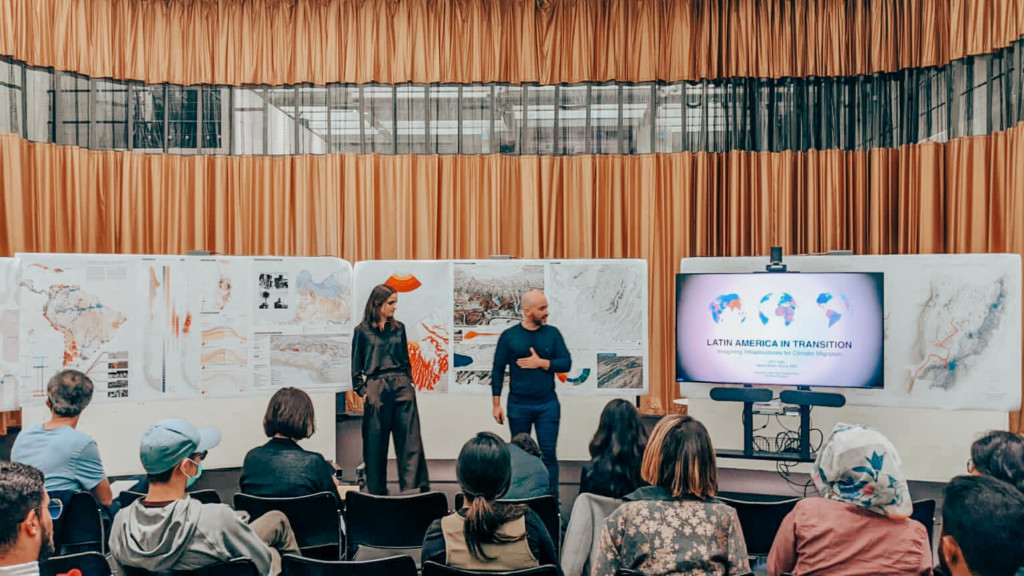
Soledad Patiño (left) and Felipe Vera (right) introduce the course brief during the studio’s mid-review.
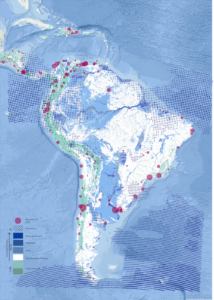
Map by Tanushri Dalmiya (MAUD ’23), Sunghea Khil (MUP ’22), and Noshin Khan (MArch I ’23) depicting the degrees of wetness and future migratory patterns across cities.
If we don’t do the work well, we will lose the opportunity to have migration as a driver for development and growth.
Felipe Vera
